CADILLAC FLEETWOOD 1994 Owners Manual
Manufacturer: CADILLAC, Model Year: 1994, Model line: FLEETWOOD, Model: CADILLAC FLEETWOOD 1994Pages: 398, PDF Size: 19.19 MB
Page 301 of 398
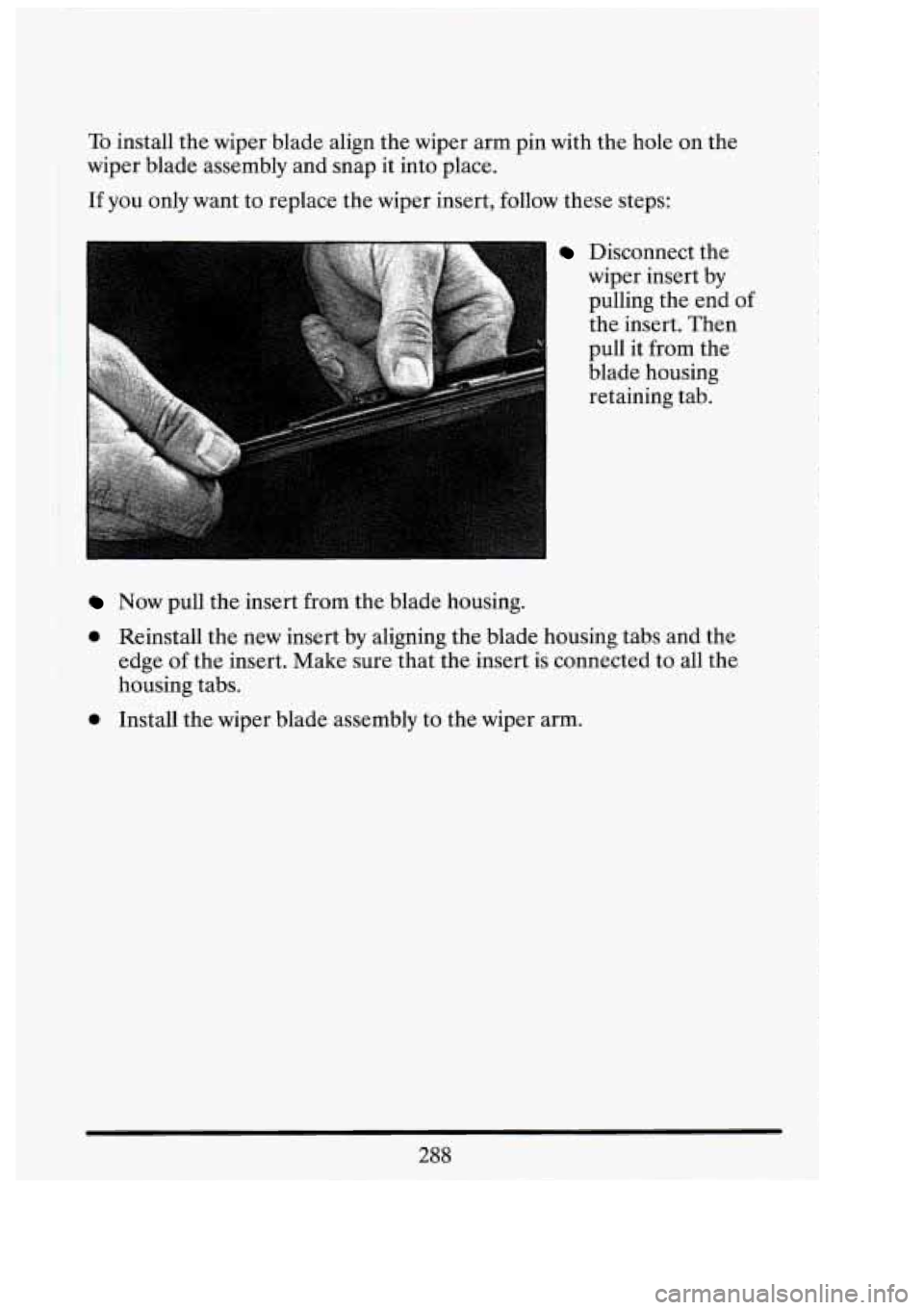
To install the wiper blade align the wiper arm pin with the hole on the
wiper blade assembly and snap it into place.
If you only want to replace the wiper insert, follow these steps:
I
Disconnect the
wiper insert by
pulling the end of
the insert. Then
pull it from the
blade housing
retaining tab.
Now pull the insert from the blade housing.
0 Reinstall the new insert by aligning the blade housing tabs and the
edge of the insert. Make sure that the insert is connected to all the
housing tabs.
0 Install the wiper blade assembly to the wiper arm.
288
UI
-1 I
n
Page 302 of 398
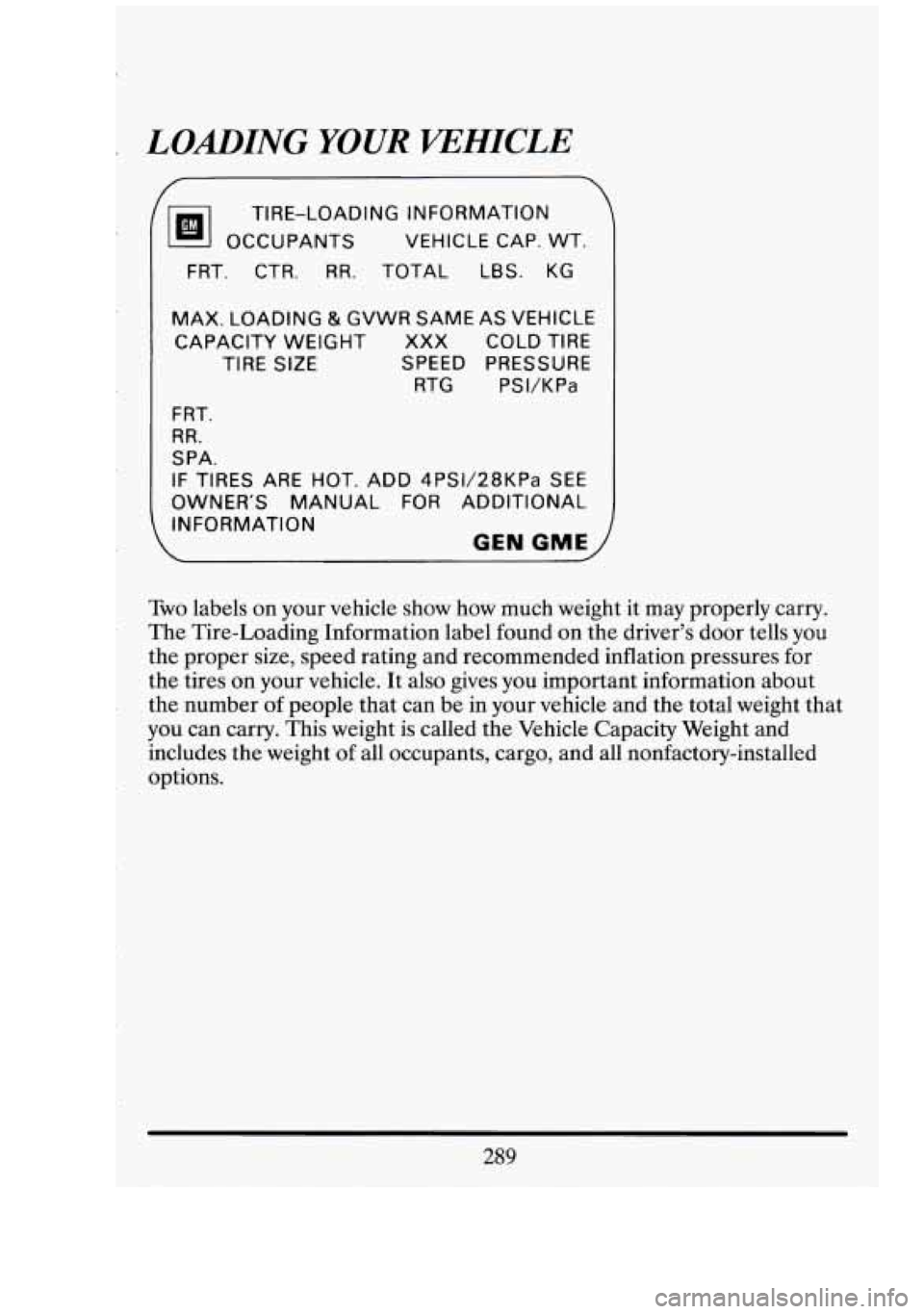
- LOADING YOUR VEHICLE
OCCUPANTS VEHICLE CAP.
WT.
TIRE-LOADING INFORMATION
FRT. CTR.
RR. TOTAL LBS. KG
MAX. LOADING
& GVWR SAME AS VEHICLE
CAPACITY WEIGHT XXX COLD
TIRE
TIRE SIZE SPEED PRESSURE RTG PSVKPa
F
RT.
RR.
SPA.
IF TIRES ARE HOT. ADD 4PSV28KPa SEE
OWNER'S MANUAL FOR ADDITIONAL
INFORMATION
GEN GME I
IWO labels oflybuf vehicle show how much weight it may properly carry.
The Tire-Loading Information label found
on the driver's door tells you
the proper size, speed rating and recommended inflation pressures for
the tires on your vehicle. It also gives you important information about
the number
of people that can be in your vehicle and the total weight that
you can carry. This weight is called the Vehicle Capacity Weight and
includes the weight
of all occupants, cargo, and all nonfactory-installed
options.
289
Page 303 of 398
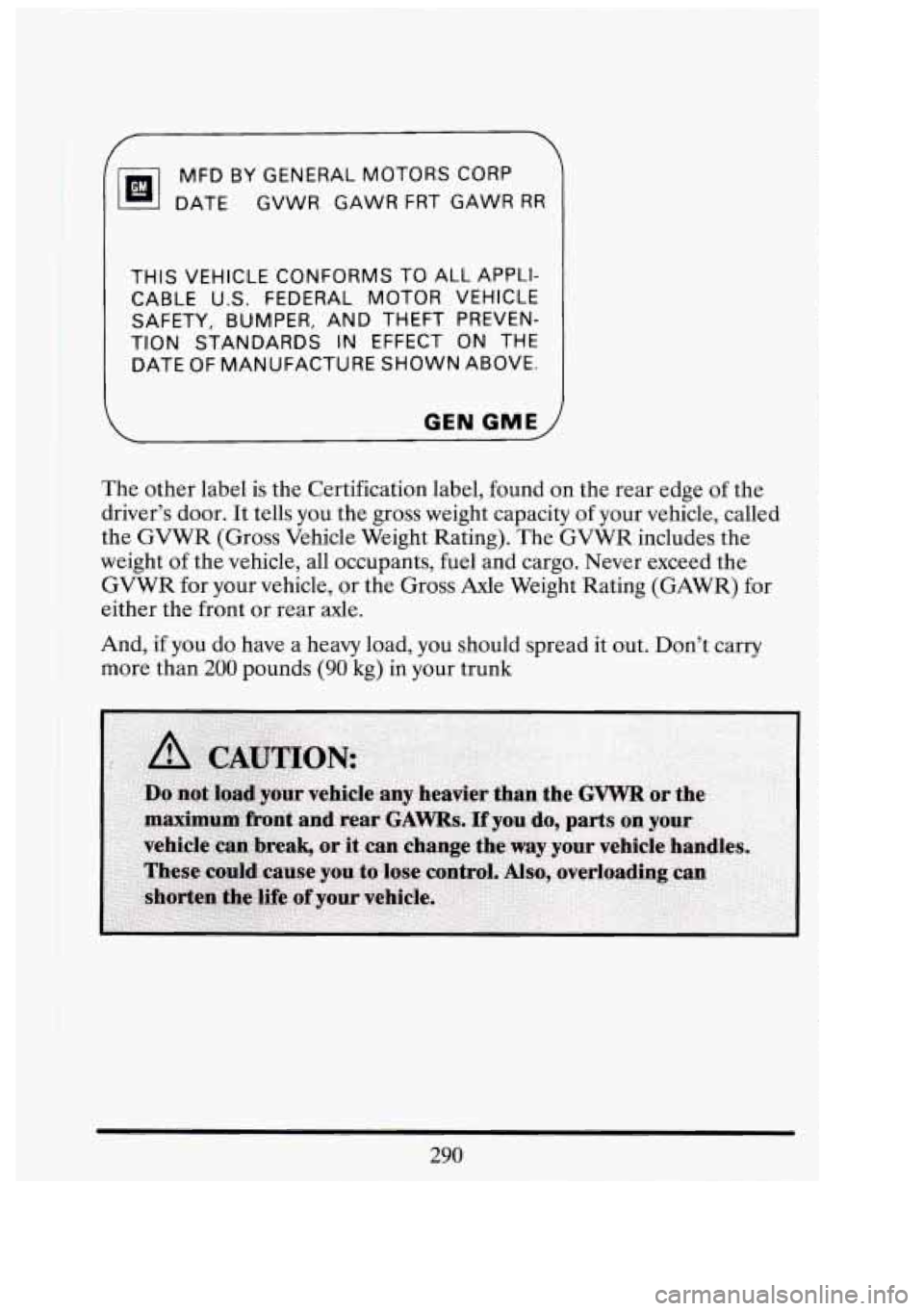
MFD BY GENERAL MOTORS CORP
DATE GVWR GAWR FRT GAWR
RR
THIS VEHICLE CONFORMS TO ALL APPLI-
CABLE
U.S. FEDERAL MOTOR VEHICLE
TION STANDARDS IN EFFECT ON THE
DATE
OF MANUFACTURE SHOWN ABOVE.
SAFETY,
BUMPER, AND THEFT PREVEN-
GEN GME
The other label is the Certification label, found on the rear edge of the
driver's door. It tells you the gross weight capacity of your vehicle, called
the GVWR (Gross Vehicle Weight Rating). The GVWR includes the
weight
of the vehicle, all occupants, fuel and cargo. Never exceed the
GVWR for your vehicle, or the Gross Axle Weight Rating (GAWR) for
either the front or rear
axle.
And, if you do have a heavy load, you should spread it out. Don't carry
more than
200 pounds (90 kg) in your trunk
r'tr
ni
L.
290
Page 304 of 398
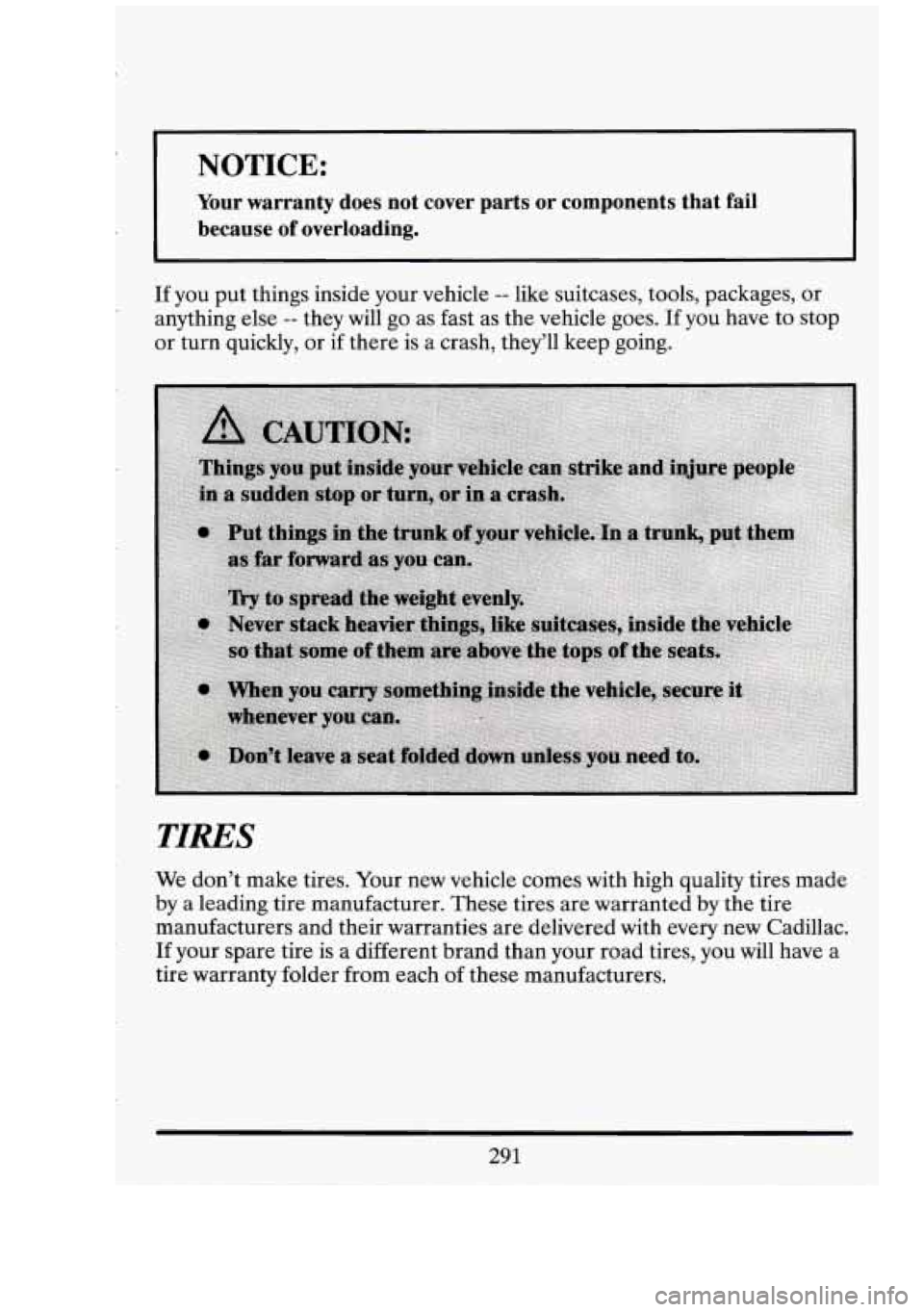
NOTICE:
Your warranty does not cover parts or components that fail
because of overloading.
If you put things inside your vehicle -- like suitcases, tools, packages, or
anything else
-- they will go as fast as the vehicle goes. If you have to stop
or turn quickly, or
if there is a crash, they’ll keep going.
TIRES
We don’t make tires. Your new vehicle comes with high quality tires made
by a leading tire manufacturer. These tires are. warranted by the tire
manufacturers and their warranties are delivered with every new Cadillac.
If your spare tire is a different brand than your road tires, you will have a
tire warranty folder from each of these manufacturers.
291
Page 305 of 398
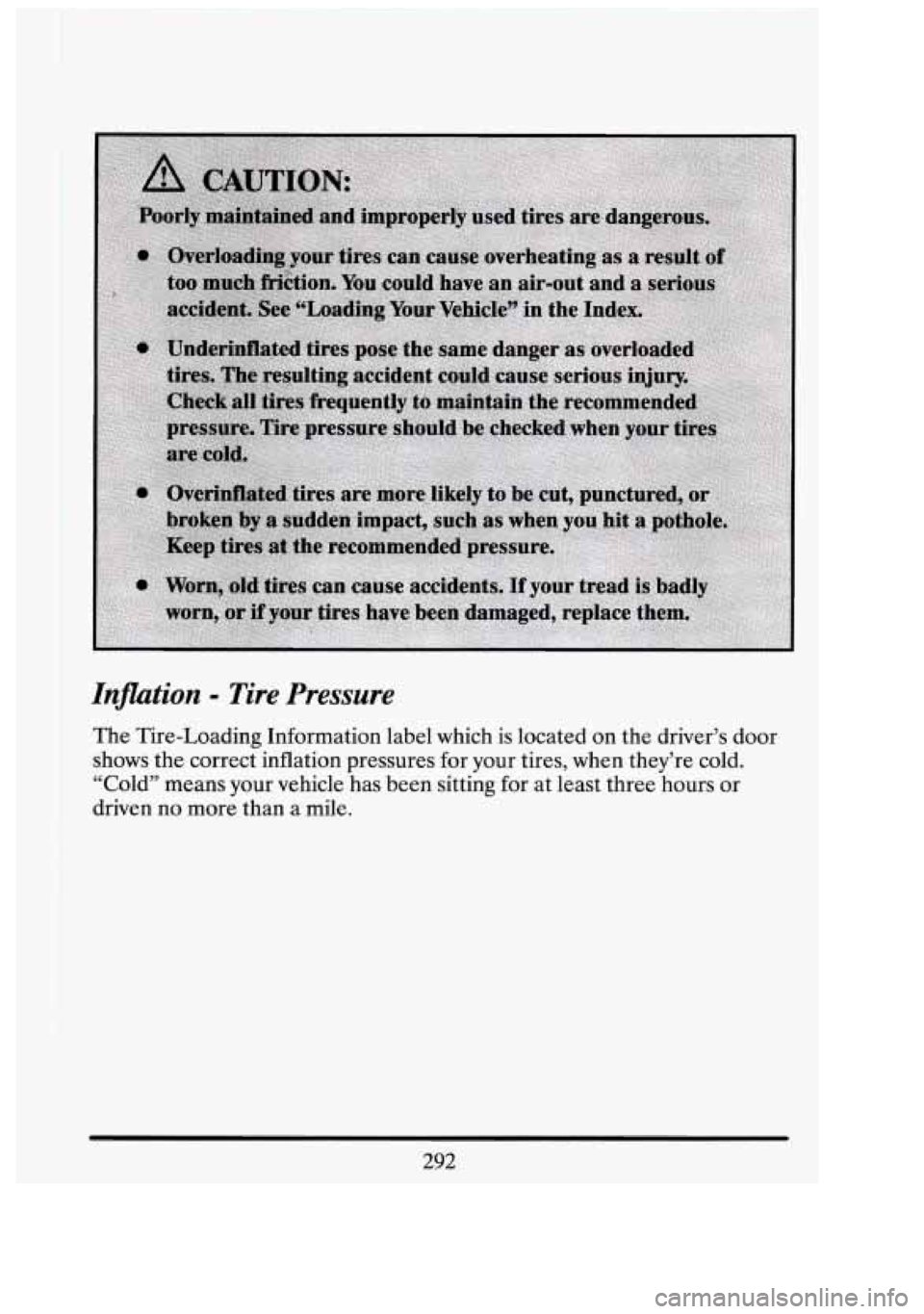
I I
Inflation = Tire Pressure
The Tire-Loading Information label which is located on the driver’s door
shows the correct inflation pressures for your tires, when they’re cold.
I “Cold” means your vehicle has been sitting for at least three hours or
driven no more than a mile.
I J
292
Page 306 of 398
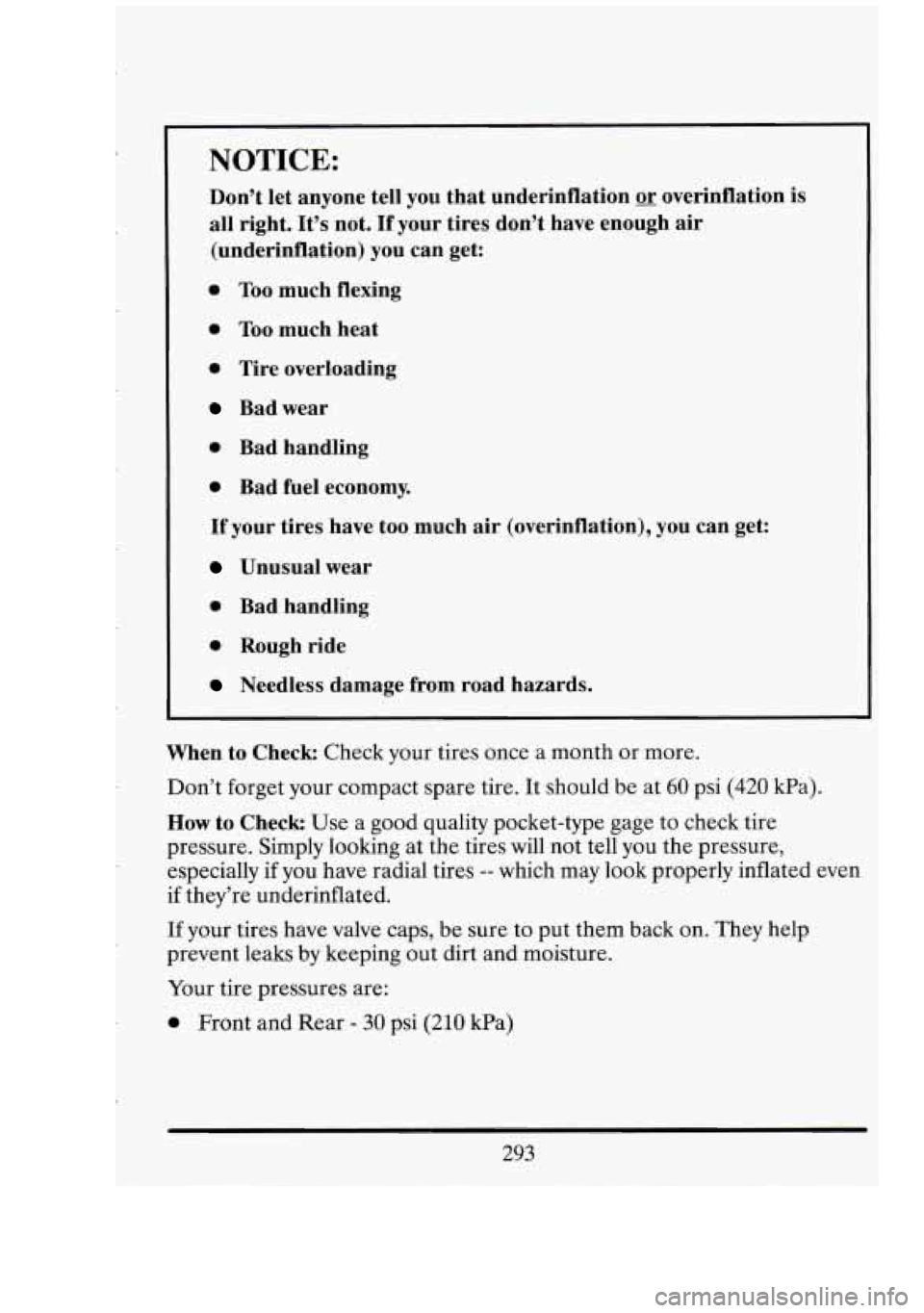
r
c-
NOTICE:
Don’t let anyone tell you that underinflation or overinflation is
all right. It’s not. If your tires don’t have enough air
(underinflation) you can get:
0 Too much flexing
0 Too much heat
0 Tire overloading
Bad wear
0 Bad handling
0 Bad fuel economy.
If your tires have too much
air (overinflation), you can get:
Unusual wear
0 Bad handling
0 Rough ride
Needless damage from road hazards.
When to Check Check your tires once a month or more.
Don’t forget your compact spare tire. It should be at
60 psi (420 kPa).
How to Check Use a good quality pocket-type gage to check tire
pressure. Simply looking at the tires will not tell
you the pressure,
especially if you have radial tires
-- which may look properly inflated even
if they’re underinflated.
If your tires have valve caps, be sure to put them back on. They help
prevent leaks by keeping out dirt and moisture.
Your tire pressures are:
0 Front and Rear - 30 psi (210 kPa)
293
Page 307 of 398
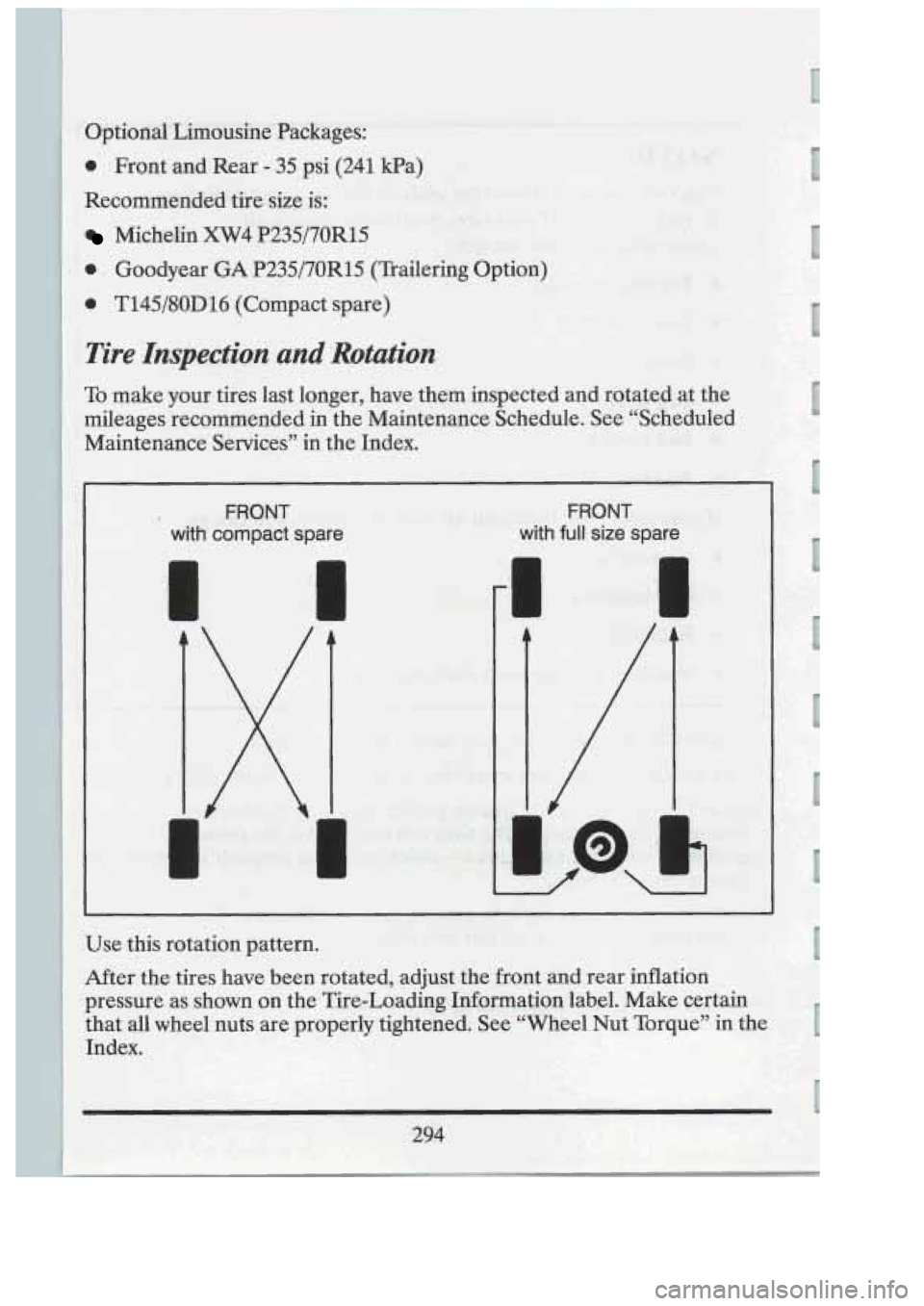
3ptional Limousine Packages:
'0 Front and Rear - -35, psi (241 Wa)
Recommended tiresize
is:
'Michelin XW4 P235/70R15 ~.
. 4 Goodyear GA P235/70R15 (Trallermg Option)
0 T145/80D16 (Comnact soare)
Tire Inspection and Rotation
To make your tires last longer, have them inspected and rotated at the
mileages recommended in the Maintenance Schedule. See "Scheduled
Maintenance Services'!
in the Index.
with compact Ispare with fullsize spare
"
4 U
Use .this rotation patte
After-the tires have
b
. . 294
Page 308 of 398

When It’s Time for New .Tires
You need a new tire if
One way to tell when
it’s time for new tires is
to check the treadwear
indicators, which
will
appear when your tires
have only
2/32 inch
(1.6 mm) or less of
tread remaining.
0 You can see the indicators at three or more places around the tire.
0 You can see cord or fabric showing through the tire’s rubber.
The tread or sidewall is cracked, cut or snagged deep enough to show
cord or fabric.
The tire has a bump,. bulge or split.
295
Page 309 of 398
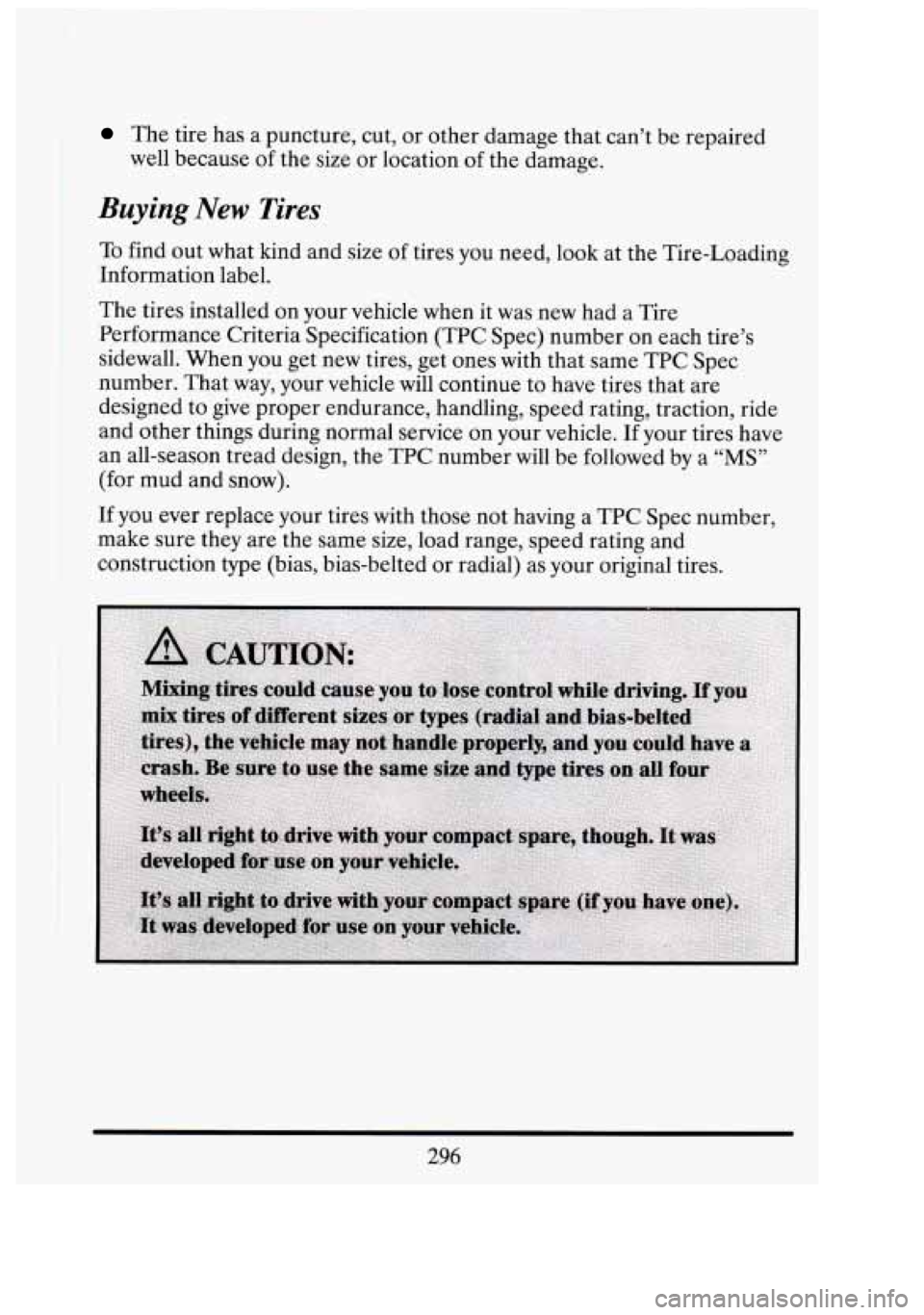
The tire has a puncture, cut, or other damage that can’t be repaired
well because of the size or location of the damage.
Buying New Tires
To find out what kind and size of tires you need, look at the Tire-Loading
Information label.
The tires installed on your vehicle
when it was new had a Tire
Performance Criteria Specification (TPC Spec) number on each tire’s
sidewall. When you get new tires, get ones with that same TPC Spec
number. That way, your vehicle will continue to have tires that are
designed to give proper endurance, handling, speed rating, traction, ride
and other things during normal service on your vehicle. If your tires have
an all-season tread design, the TPC number
will be followed by a “MS”
(for mud and snow).
If you ever replace your tires with those not having a TPC Spec number,
make sure they are the same size, load range, speed rating and
construction type (bias, bias-belted or radial) as your original tires.
ni
-1
Page 310 of 398
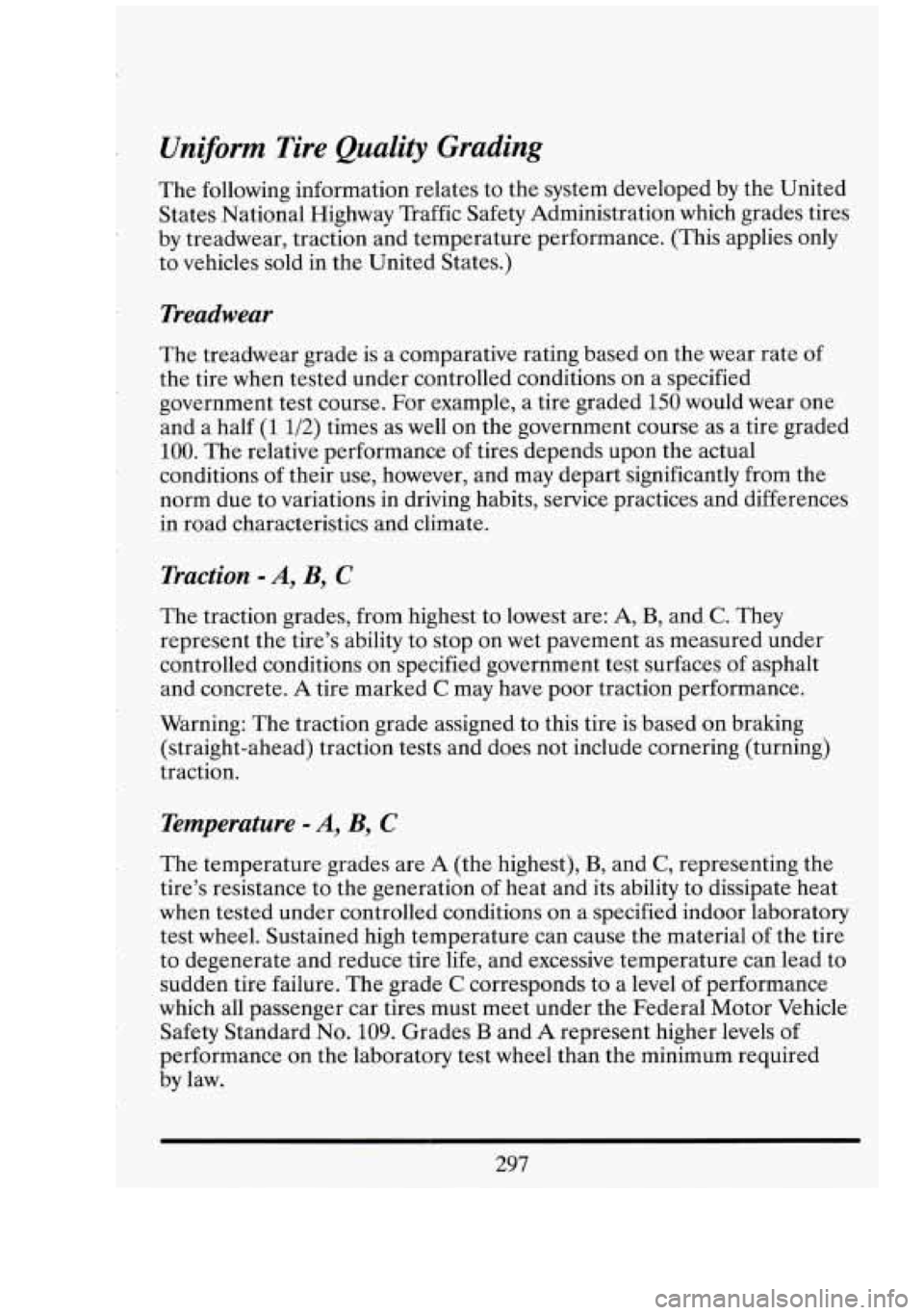
Uniform Tire Quality Grading
The following information relates to the system developed by the United
States National Highway Traffic Safety Administration which grades tires
by treadwear, traction and temperature performance. (This applies only
to vehicles sold
in the United States.)
Treadwear
The treadwear grade is a comparative rating based on the wear rate of
the tire when tested under controlled conditions on a specified
government test course. For example, a tire graded 150 would wear one
and
a half (1 1/2) times as well on the government course as a tire graded
100. The relative performance of tires depends upon the actual
conditions of their use, however, and may depart significantly from the
norm due to variations in driving habits, service practices and differences
in road characteristics and climate.
Traction - A, B, C
The traction grades, from highest to lowest are: A, B, and C. They
represent the tire’s ability to stop on wet pavement as measured under
controlled conditions on specified government test surfaces
of asphalt
and concrete. A tire marked
C may have poor traction performance.
Warning: The traction grade assigned to this tire is based
on braking
(straight-ahead) traction tests and does not include cornering (turning)
traction.
Temperature - A, B, C
The temperature grades are A (the highest), B, and C, representing the
tire’s resistance to the generation of heat and its ability to dissipate heat
when tested under controlled conditions on a specified indoor laboratory
test wheel. Sustained high temperature can cause the material of the tire
to degenerate and reduce tire
life, and excessive temperature can lead to
sudden tire failure. The grade
C corresponds to a level of performance
which all passenger car tires must meet under the Federal Motor Vehicle
Safety Standard No. 109. Grades
B and A represent higher levels of
performance on
the laboratory test wheel than the minimum required
by law.
297